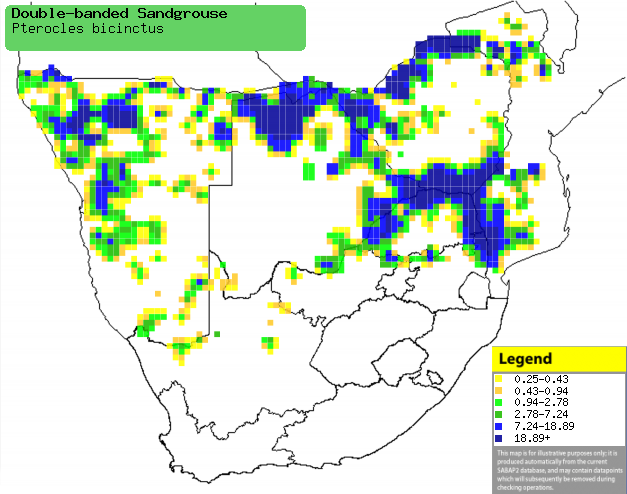|
Pterocles bicinctus
(Double-banded sandgrouse)
Dubbelbandsandpatrys [Afrikaans]; Simbote (generic
term for sandgrouse) [Kwangali]; Xighwaraghwara [Tsonga]; Mokgwarakgwara
[Tswana]; Dubbelbandzandhoen [Dutch]; Ganga bibande [French]; Nachtflughuhn
[German]; Corticol-de-duas-golas [Portuguese]
Life
> Eukaryotes >
Opisthokonta
> Metazoa (animals) >
Bilateria >
Deuterostomia > Chordata >
Craniata > Vertebrata (vertebrates) > Gnathostomata (jawed
vertebrates) > Teleostomi (teleost fish) > Osteichthyes (bony fish) > Class:
Sarcopterygii (lobe-finned
fish) > Stegocephalia (terrestrial
vertebrates) > Tetrapoda
(four-legged vertebrates) > Reptiliomorpha > Amniota >
Reptilia (reptiles) >
Romeriida > Diapsida > Archosauromorpha > Archosauria >
Dinosauria
(dinosaurs) > Saurischia > Theropoda (bipedal predatory dinosaurs) >
Coelurosauria > Maniraptora > Aves
(birds) > Order: Charadriiformes
> Family: Pteroclidae
Distribution and habitat
Near-endemic to southern Africa, occurring from southern
Angola, southern and eastern Zambia and marginally southern Malawi to Namibia,
northern and eastern Botswana, northern and southern Botswana, Mozambique and
northern South Africa. It generally prefers Mopane (Colosphermum mopane)
woodland, although it may also occur in Acacia and other wooded savannas,
especially with gravel plains or low hills with tussocky grass and scrub.
|
 |
|
Distribution of Double-banded sandgrouse in
southern Africa, based on statistical smoothing of the records from
first SA Bird Atlas Project (©
Animal Demography unit, University of
Cape Town; smoothing by Birgit Erni and Francesca Little). Colours range
from dark blue (most common) through to yellow (least common).
See here for the latest distribution
from the SABAP2. |
Predators and parasites
It has been recorded as prey of
Falco peregrinus
(Peregrine falcon).
Movements and migrations
Thought to be largely sedentary, although it
may make local movements in search of water, especially in the dry
season.
Food
It mainly eats seeds, doing most of it foraging in the
early morning, late afternoon and at night (provided there is enough moonlight). The following food items have been recorded
in its diet:
- seeds
- Acacia
- Requenia sphaerosperma (Red pea)
- Tephrosia
- Cyperus
- Bidens bidentata (Blackjack)
- Datura innoxia (Hairy thorn-apple)
Breeding
- Monogamous, solitary nester, with them male performing a pre-copulatory
display in which he slowly walks around near the female with his tail
pointing upwards and his bill pointed toward the ground.
- The nest is a shallow scrape in the soil, gravel or sand, typically
lined with a few pieces of dry plant material and placed between grass
tufts, beneath a bush or out in the open.
- Egg-laying season is from February-September, peaking from May-August in
Namibia and Botswana and from July-September in Zimbabwe and northern South
Africa.
- It lays 2-3 eggs, which are incubated by both sexes for about 23-24 days
(recorded in captivity).
- The development and care of the chicks is little known, but it is
thought that chicks can fly strongly by the time they are roughly a month
old, developing the adult plumage 2-5 months later.
Threats
Not threatened, in fact it is well represented in protected
areas and has moved into more arid areas thanks to the construction of
artificial water bodies.
References
-
Hockey PAR, Dean WRJ and Ryan PG 2005. Roberts
- Birds of southern Africa, VIIth ed. The Trustees of the John Voelcker
Bird Book Fund, Cape Town.
|
